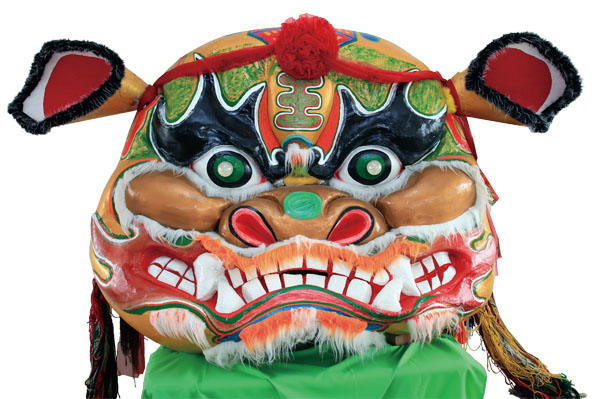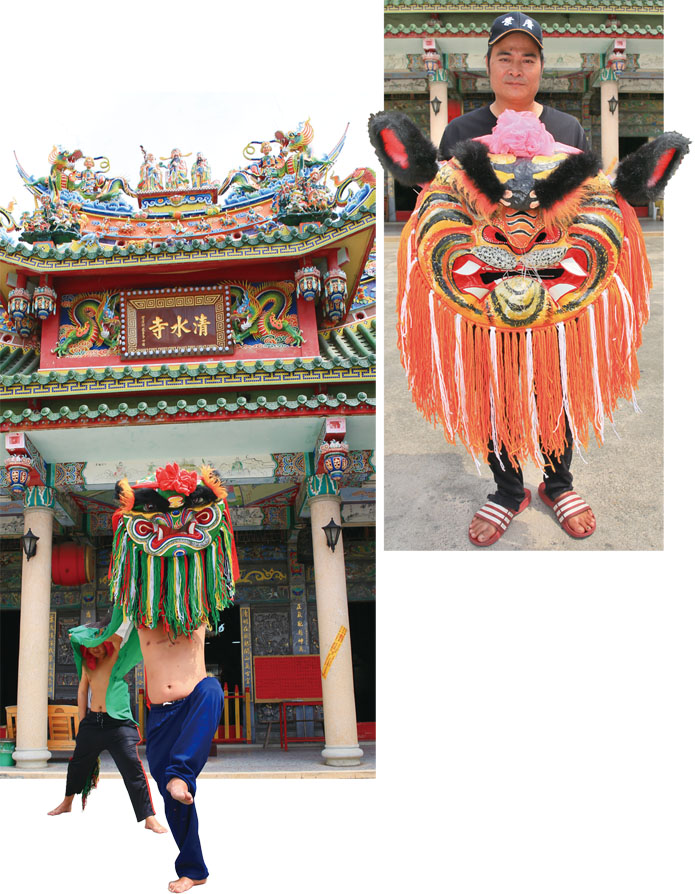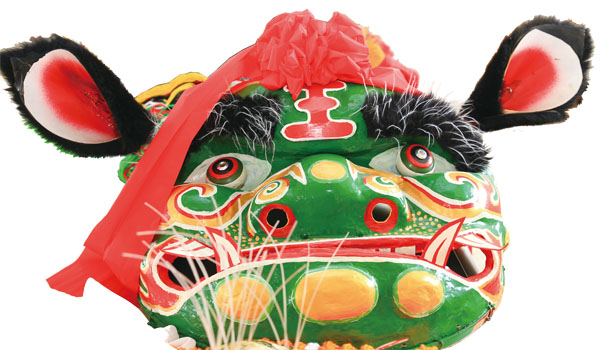Innovating Tradition: Pan Ruei-hua's Lion-Dance Dream Comes True/既傳統又創新 潘瑞華 舞獅也舞夢
Innovating Tradition: Pan Ruei-hua's Lion-Dance Dream Comes True
◎English translation: Peng Hsin-yi
◎Photos by Lin Yu-hung
 Lion dance is one of Taiwan's most popular folk traditions. Few know, however, that the lions' heads are handmade by skilled artisans, and Artisan Mr. Pan Ruei-hua, who has won recognition for this kind of art, is considered one of the three most significant artisans in Taiwan. He comes from a family which runs a martial arts club and Songjiang Lion Dance over a century. Mr. Pan learned the art of making lions' heads from his grandfather, and his early start allows him to boast of 35 years' experience while being aged just 41. The Pan family takes the tradition very seriously; their lions' heads are still made using clay molds and papier-mache.
Lion dance is one of Taiwan's most popular folk traditions. Few know, however, that the lions' heads are handmade by skilled artisans, and Artisan Mr. Pan Ruei-hua, who has won recognition for this kind of art, is considered one of the three most significant artisans in Taiwan. He comes from a family which runs a martial arts club and Songjiang Lion Dance over a century. Mr. Pan learned the art of making lions' heads from his grandfather, and his early start allows him to boast of 35 years' experience while being aged just 41. The Pan family takes the tradition very seriously; their lions' heads are still made using clay molds and papier-mache.
Mr. Pan recalls with great fondness childhood memories of his grandfather performing the lion dance. He says there were several thousand people in the streets, all wanting to see the magnificent lion. The festive frenzy the lion was able to bring out from the crowd was mesmerizing, and as a boy he wished with all his heart that one day he would impress an audience through lion dancing.
Mr. Pan began training martial arts and Songjiang Lion Dance when he was just six years old. At the same time, he started learning the craft of making lions' heads. By 1998, when he was 24 years old, he was already the club's grand master. Under his leadership, the family's Songjiang Battle Array – named The Black Heaven Master's Altar Brigade – won second place in the President's Cup Lion Dance Tournament. His lions' heads were able to blink their eyes and twitch their ears, thanks to levers inside the heads operated by the dancers. Mr. Pan's choreography was lively and energetic, deeply impressing the audience.
Mr. Pan says the lion dance and the making of lions' heads has been passed down from father to son in his family. To make a lion's head, he starts with a type of clay that has great elasticity. With it, he sculpts the facial features, then adds layers and layers of newspaper to a clay mold using a traditional glue which blends sticky rice, raw cane sugar and sweet potato starch. Each layer takes two days to dry, and there are 20 layers in all. When the paper is dry, he removes the clay mold, and the lion's head is ready. When asked why he never uses modern adhesives, he stresses that making lions' heads is a tradition, so traditional methods must be used. Perhaps he feels that he lives to preserve this tradition; his life is already one facet of the tradition he strives to maintain.
 Mr. Pan feels especially inspired at night when he paints the lions' heads. He had made over a thousand heads, but has never repeated himself. He says there is no fun in making the same thing over and over again. Often, he picks up the brush in the early evening and paints through the night. He says the painting of lions' heads must be done in one sitting, or the colors will not be as beautiful. Asked how long a lion's head lasts, he points to one hanging on the wall that was made by his great-grandfather. It is still as perfect as the day it was made.
Mr. Pan feels especially inspired at night when he paints the lions' heads. He had made over a thousand heads, but has never repeated himself. He says there is no fun in making the same thing over and over again. Often, he picks up the brush in the early evening and paints through the night. He says the painting of lions' heads must be done in one sitting, or the colors will not be as beautiful. Asked how long a lion's head lasts, he points to one hanging on the wall that was made by his great-grandfather. It is still as perfect as the day it was made.
Mr. Pan enjoys making lions' heads so that he continues to produce at least 12 every year. In 2007, he made an extra large one weighing 50 kg (about 110 lbs) which is now the pride of Yecuo Community in Kaohsiung City's Hunei District, where he resides. Mr. Pan also gives lectures at community education programs and design institutes, so as to expose the general public to this art.
When Mr. Pan is hired to perform the Songjiang Lion Dance, he regards it not simply as a job, but something he does with pride. Ten years ago, he broke the mold of traditional routines, adding firecrackers to his performance and inventing the "Crackling Songjiang Array." He thus became an industry leader. The sound of firecrackers ushers in an atmosphere of festivity; people associate the noise with prosperity, and believe that the louder the firecrackers, the better business will be in the coming year. This performance is not for the faint of heart, it requires boldness and calmness in a literally explosive environment. The "Crackling Songjiang Array" has been invited to perform at important festivals and religious ceremonies, such as the pilgrimage which starts from Dajia District in Taichung City and honors Mazu, the patron goddess of sailors and travelers, and the Bombing of Master Handan in Taidong City. Each time, his performance wows the crowd.
Lion-dance performances and the making of lions' heads are important parts of Taiwan's traditional culture. Artisans like Mr. Pan are working hard to preserve them, and are proud to present them to every kind of audience.
既傳統又創新 潘瑞華 舞獅也舞夢
◎文/侯雅婷
◎攝影/林裕鈜
41歲的潘瑞華是台灣三大傳統手工獅頭藝師之一。家族世代經營武館、陣頭逾一世紀,他自小跟著曾祖父學習手工獅頭工藝迄今35載,堅守傳統工法,製作泥坯紙糊法的獅頭。
潘瑞華憶起幼時見到曾祖父舞獅表演,數萬名觀眾夾道歡迎,熱烈風光的場面讓他體會舞獅帶來榮耀,並憧憬著有朝一日也能以高超的獅藝贏得讚賞。
潘瑞華自6歲開始練拳、舞宋江獅陣頭和學習製作手工宋江獅頭,22歲那年(1998年),更以總教練之姿,率領家族宋江獅團「先師壇玄天會」獲得總統盃舞獅錦標大賽第二名的殊榮。潘瑞華製作的宋江獅頭會眨眼、耳朵會動,配合生動的肢體動作,活靈活現的獅頭一登場,驚艷全場!
潘瑞華說,傳統手工獅頭這門工藝潘家只傳子孫。製作獅頭選用具彈性土質塑出獅頭五官,依古法調製糯米漿、黑糖和蕃薯粉漿做為黏著劑,浮貼一片片的報紙在土塑模形上,每黏好一層得放置2天陰乾,需反覆貼上20層之後取出模型內的土模,獅頭模型才大功告成。當被問起為何不使用現成的黏著劑,他不假思索地說:「獅頭必需遵循傳統製法。」保存傳統文化的精神早內化於生活之中。
 夜裡,潘瑞華彩繪獅頭的靈感源源不絕,繪製逾一千個獅頭,造型不曾重覆,他說,「就是要做不一樣的獅頭才有趣!」潘瑞華說彩繪獅頭得一氣呵成,漆彩才上得漂亮,他往往提筆一畫就是一夜到天亮。而紙製的獅頭究竟能保存多久?他指著牆上獅頭說:「曾祖父製作的獅頭至今仍完好無暇!」
夜裡,潘瑞華彩繪獅頭的靈感源源不絕,繪製逾一千個獅頭,造型不曾重覆,他說,「就是要做不一樣的獅頭才有趣!」潘瑞華說彩繪獅頭得一氣呵成,漆彩才上得漂亮,他往往提筆一畫就是一夜到天亮。而紙製的獅頭究竟能保存多久?他指著牆上獅頭說:「曾祖父製作的獅頭至今仍完好無暇!」
做獅頭是潘瑞華的興趣,每年至少繪製12頂獅頭。2007年時,他曾創作出50公斤的大獅頭,成為葉厝社區的一大亮點。此外,他推廣傳統獅頭工藝不遺餘力,在他居住的葉厝社區和設計學院等地傳授獅頭工藝。
潘瑞華接演陣頭表演不僅視為一份工作,更視為榮耀。10年前,潘瑞華以獨門的「炮炸宋江陣」表演,確立在陣頭表演中無可撼動的地位,「炮炸宋江獅」具有吉祥意涵,據說炸炮數量越多,生意越是興隆,表演者得有過人的膽識方能在震耳欲聾的炮炸環境演出,炮炸宋江獅每年僅於大甲媽祖遶境、台東寒單爺等全台知名節慶活動演出,屢屢造成轟動。
無論是陣頭表演,乃至於傳統手工獅頭創作,呈現觀眾眼前的是這些獅頭藝師和職人最引以為傲的舞獅文化。